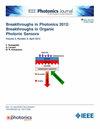Real-Time Software Implementation of Filter-Separated MIMO Adaptive Equalizer for Fully Virtualized Access Networks
IF 2.1
4区 工程技术
Q3 ENGINEERING, ELECTRICAL & ELECTRONIC
引用次数: 0
Abstract
Developing dedicated hardware for each application in future optical access network systems causes significant initial investment costs. Thus, these costs are alleviated by optical access networks using general-purpose devices related to software-defined networking (SDN) and network function virtualization (NFV). We have studied physical layer virtualization to bring the advantages of SDN and NFV in optical access networks. We have focused on digital coherent technology to enhance capacity and extend reach within optical access networks. However, the future virtualized coherent access faces stringent frequency characteristics and the impact of chromatic dispersion (CD). The number of taps of finite impulse response (FIR) filters in the receiver increases rapidly for the CD compensation. The previously proposed DSP algorithm may not operate in this situation because the processing time exceeds the requirement. Therefore, this paper proposes and implements software for a lightweight multi-input-to-multi-output (MIMO) adaptive equalizer that separates FIR filters depending on the tap update period. The proposed method uses two types of FIR filters; one is used for polarization demultiplexing with short taps, and the other is a filter with long taps for the compensation of the CD in the fiber channel and the frequency distortion from the transceiver. Owing to filter separation, the calculation cost can be reduced. We indicate the processing time meeting desired requirements through real-time transmission experiments, even with increased taps. Additionally, we conduct offline simulations and experiments at a higher symbol rate than the real-time experiment.针对完全虚拟化接入网络的滤波器分离式多输入多输出自适应均衡器的实时软件实现
在未来的光接入网络系统中,为每种应用开发专用硬件都会产生巨大的初始投资成本。因此,使用与软件定义网络(SDN)和网络功能虚拟化(NFV)相关的通用设备的光接入网络可以降低这些成本。我们研究了物理层虚拟化,以便在光接入网中发挥 SDN 和 NFV 的优势。我们重点研究了数字相干技术,以提高光接入网的容量并扩大其覆盖范围。然而,未来的虚拟化相干接入面临着严格的频率特性和色度色散(CD)的影响。为了进行 CD 补偿,接收器中有限脉冲响应(FIR)滤波器的抽头数量迅速增加。之前提出的 DSP 算法在这种情况下可能无法运行,因为处理时间超出了要求。因此,本文提出并实施了一种轻量级多输入多输出(MIMO)自适应均衡器软件,该均衡器可根据抽头更新周期分离 FIR 滤波器。所提出的方法使用两种类型的 FIR 滤波器,一种用于短抽头的极化解复用,另一种是长抽头滤波器,用于补偿光纤通道中的 CD 和收发器产生的频率失真。由于滤波器分离,计算成本得以降低。我们通过实时传输实验表明,即使增加抽头,处理时间也能满足预期要求。此外,我们还以比实时实验更高的符号率进行了离线模拟和实验。
本文章由计算机程序翻译,如有差异,请以英文原文为准。
求助全文
约1分钟内获得全文
求助全文
来源期刊

IEEE Photonics Journal
ENGINEERING, ELECTRICAL & ELECTRONIC-OPTICS
CiteScore
4.50
自引率
8.30%
发文量
489
审稿时长
1.4 months
期刊介绍:
Breakthroughs in the generation of light and in its control and utilization have given rise to the field of Photonics, a rapidly expanding area of science and technology with major technological and economic impact. Photonics integrates quantum electronics and optics to accelerate progress in the generation of novel photon sources and in their utilization in emerging applications at the micro and nano scales spanning from the far-infrared/THz to the x-ray region of the electromagnetic spectrum. IEEE Photonics Journal is an online-only journal dedicated to the rapid disclosure of top-quality peer-reviewed research at the forefront of all areas of photonics. Contributions addressing issues ranging from fundamental understanding to emerging technologies and applications are within the scope of the Journal. The Journal includes topics in: Photon sources from far infrared to X-rays, Photonics materials and engineered photonic structures, Integrated optics and optoelectronic, Ultrafast, attosecond, high field and short wavelength photonics, Biophotonics, including DNA photonics, Nanophotonics, Magnetophotonics, Fundamentals of light propagation and interaction; nonlinear effects, Optical data storage, Fiber optics and optical communications devices, systems, and technologies, Micro Opto Electro Mechanical Systems (MOEMS), Microwave photonics, Optical Sensors.
 求助内容:
求助内容: 应助结果提醒方式:
应助结果提醒方式:


